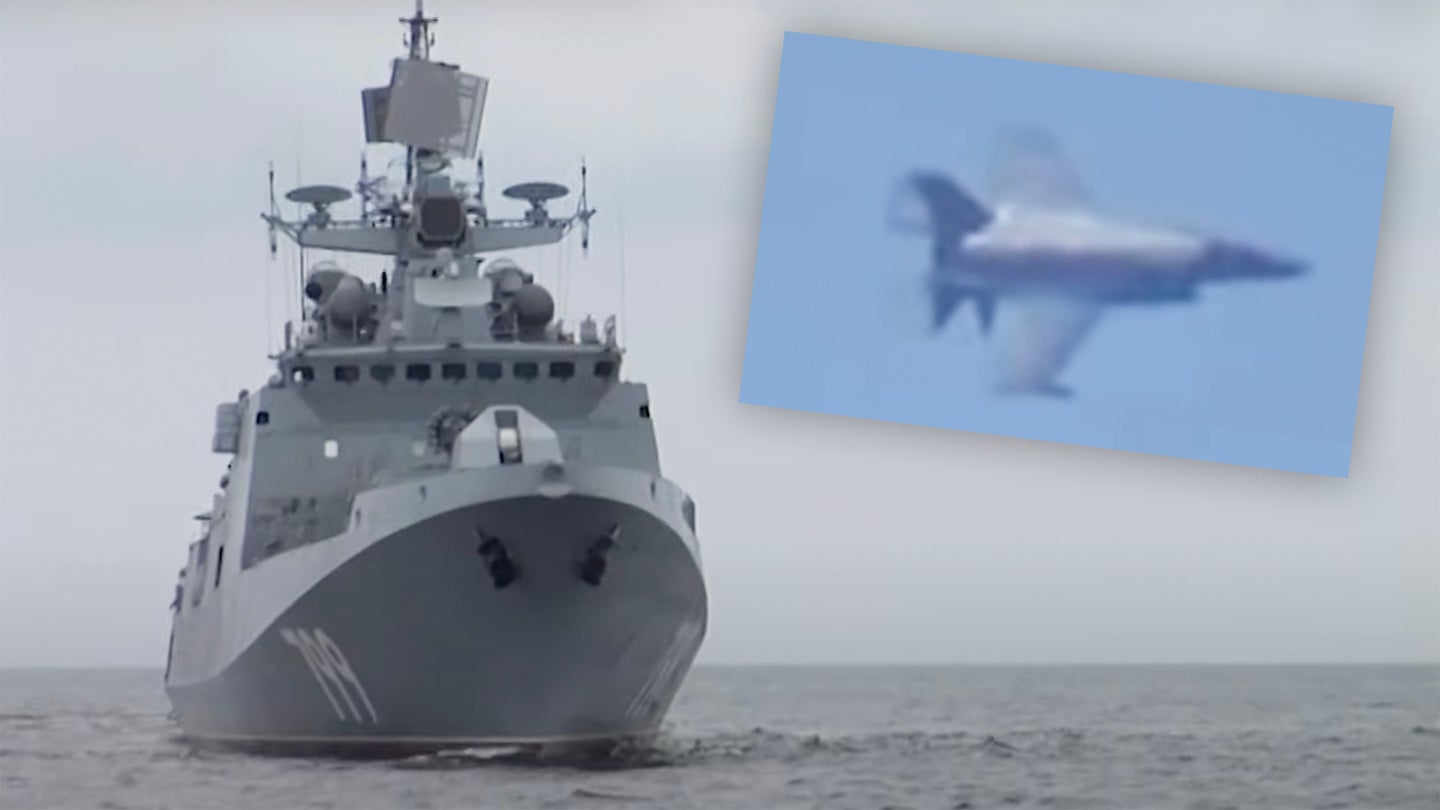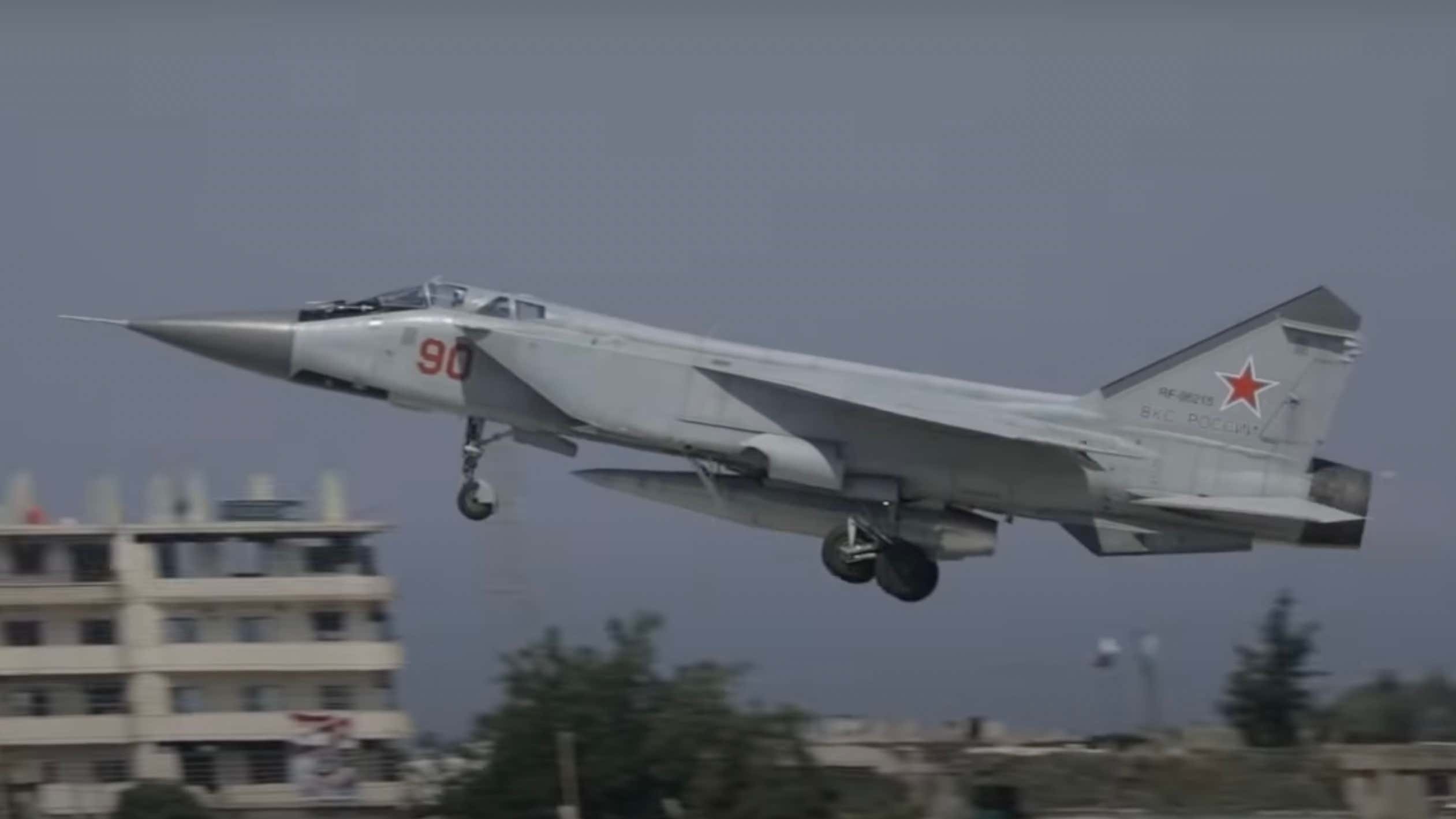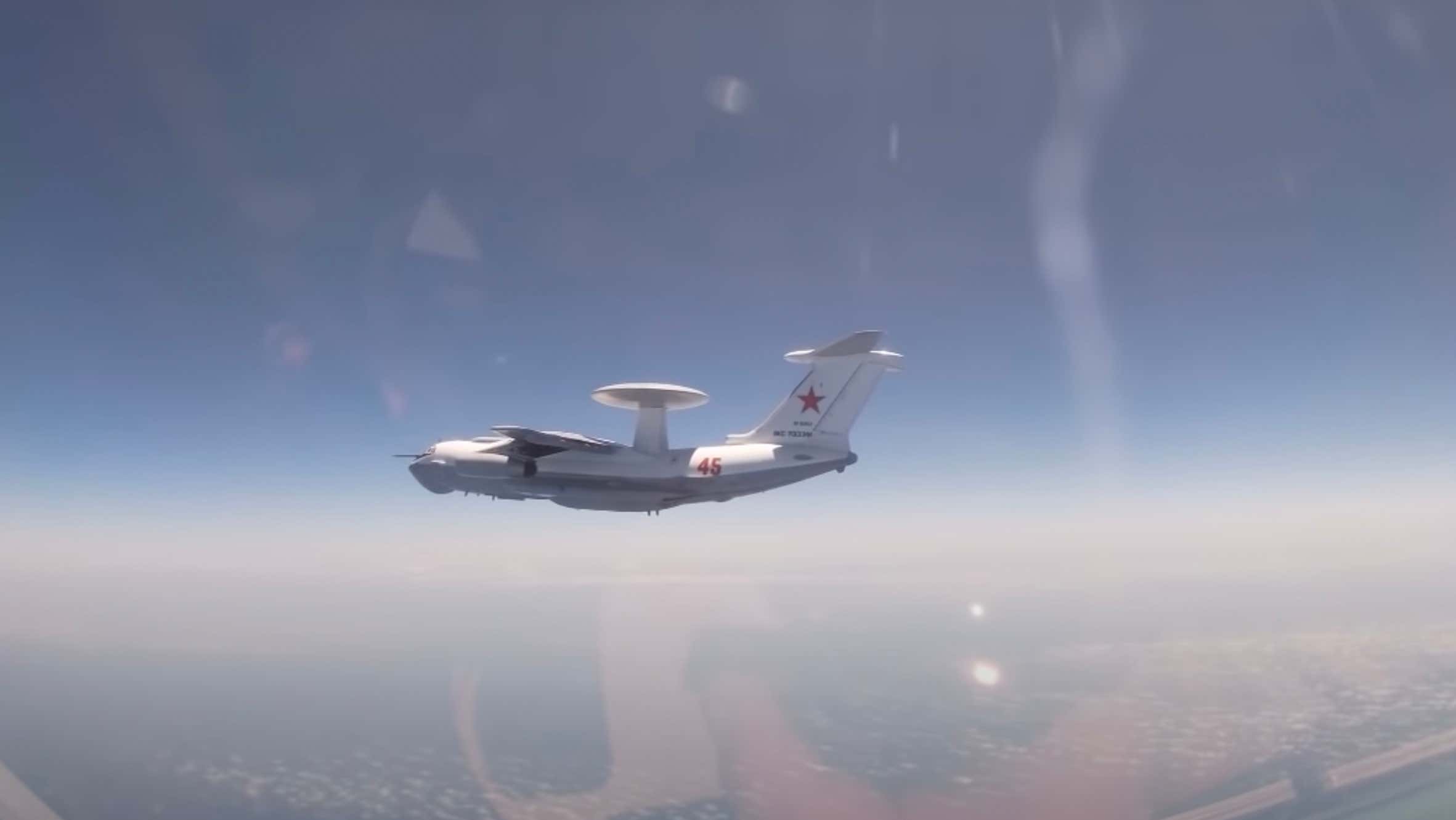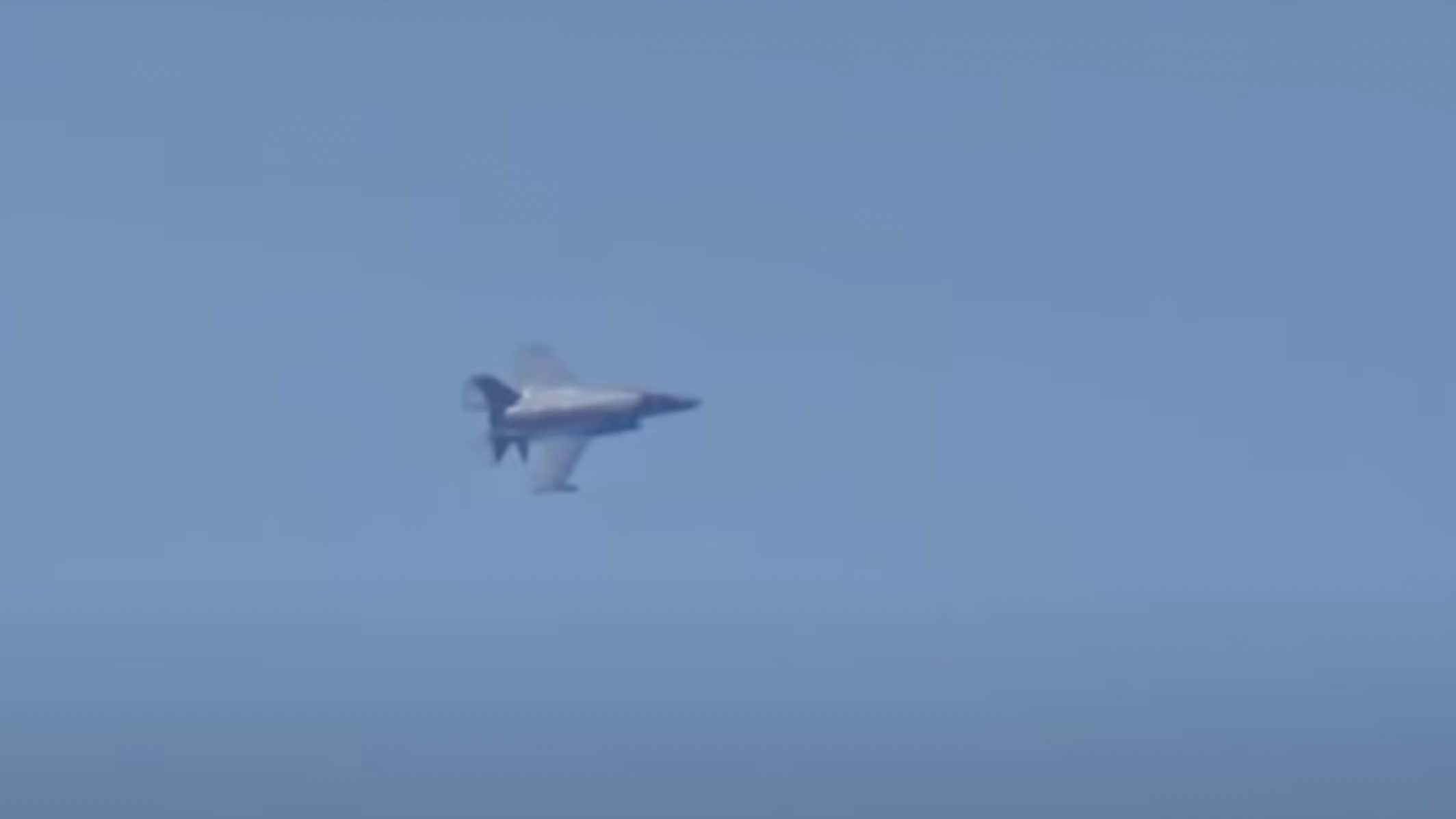
F-35B From British Carrier Flies Over Russian Forces Training To Sink Enemy Warships
Tu-22M3 bombers and MiG-31K fighters have also been brandishing their anti-ship missiles during the latest round of drills in the Mediterranean.
June 28, 2021By
Russian Ministry of Defense Screencap
The Russian naval task force deployed to Syria in recent days appears to have stepped up its drills in the eastern Mediterranean. At the same time, a recent video shows that at least some of the Russian participants have been shadowed by F-35B stealth jetsoperating from the U.K. Royal Navy aircraft carrier HMS Queen Elizabeththat’s conducting combat operations in the region, against ISIS targets. The latest Russian maneuvers come as tensions between Moscow and the United Kingdom remain high, after a Royal Navy destroyer sailed in waters close to Russian-occupied Crimea last week, and as large-scale, U.S.-led maneuvers in the Black Sea kick off today.
The latest official video of the Russian deployment reveals that at least some of the three Tu-22M3 Backfire-Cbombers and two MiG-31K Foxhoundjet fighters armed with Kinzhal hypersonic missiles that deployed to Khmeimim Air Base in Syria’s coastal Latakia province last week are now conducting joint maneuvers with Su-35S Flanker fighters. The latter type is seen flying as an escort, carrying various air-to-air missiles, and operating from the same base. Also evident is at least one Su-34 Fullback strike jet, albeit armed with only a pair of short-range missiles for self-defense. Unlike the Tu-22M3 and MiG-31K, the Su-35s and Su-34s have been seen at the Syrian airbase regularly for years now.

Previously, we have seen Tu-22M3s operating from Syria with a single example of the Kh-22 (AS-4 Kitchen) or improved Kh-32 anti-ship missile, but the video reveals a two-missile loadout. Theoretically, each Tu-22M3 can carry three of these weapons, two under the wings and one under the fuselage, but with a considerable reduction in range, since the fuel load has to be reduced accordingly. Therefore, two missiles are normally the maximum practical load, while one missile provides for a range of almost 1,400 miles. The MiG-31K is seen with its standard load of a single Kinzhal missile carried on the centerline.
These missions also included an A-50 Mainstay airborne early warning and control aircraft, which is seen in the video operating from Khmeimim, as well as over the eastern Mediterranean. This aircraft, which is a familiar presence in Syria, could be coordinating the exercise, as well as keeping an eye on other movements in the air and at sea, such as CSG21 and its F-35Bs.

One brief sequence shows an F-35B flying in a steep bank, apparently filmed from a Russian Navy warship. The distance at which the jet is shadowing the vessel means it’s unclear it was from the Royal Air Force or U.S. Marine Corps, but examples from both services are now onboard HMS Queen Elizabeth.

Finally, there is a sequence in the video from an unspecified Russian Navy warship, allegedly the Admiral Makarov, one of the two Admiral Grigorovichclass frigates that are involved in the current drills, the other being Admiral Essen. As well as commands being issued from the bridge, we see the crew racing to battle stations and close-ups of AK-630 multi-barrel gun, though no live-firing is seen. One of these same weapons was used to fire a ‘warning shot’ toward HMS Defender in the Black Sea last week.
The remaining three Russian Navy warships involved in the maneuvers are the Slava class guided-missile cruiser Moskva and the Improved Kilo classsubmarines Stary Oskol and Rostov-on-Don. All these are from Russia’s Black Sea Fleet.
Two other Russian assets that have been announced as taking part in the maneuvers have not been seen so far — these are the Il-38 May and Tu-142MK Bear-F long-range anti-submarine aircraft.
The official statement provided by the Russian Ministry of Defense reiterates the fact that the current exercises are focused on defending friendly ships against aerial attacks. The carriage of hypersonic missiles (Kinzhal) is also mentioned but it’s not clear if these were used to replicate hostile attacks on the surface combatants. That would, however, fit in with reports last week of simulated enemy aircraft flying a mock attack against a frigate with anti-ship missiles. Moreover, the defense of surface combatants against targets flying at hypersonic speed — generally taken to mean in excess of five times the speed of sound — is a growing area of concern for navies around the world. For its part, the Kinzhal, which is a converted short-range ballistic missile, is claimed to be able to fly at 10 times the speed of sound.
“Particular attention was paid to countering airplanes, helicopters, and unmanned aerial vehicles of the imaginary enemy,” the latest report explains. The same drills also include ensuring the security of Khmeimim Air Base and the Russian Navy’s logistics hub in the Syrian port of Tartus.
While this is the second time that the Tu-22M3 has been deployed to Syria, the emphasis on the type’s maritime strike mission is noteworthy, especially as it coincides with the high-profile appearance of HMS Queen Elizabeth in the Mediterranean for the first time, as first of its first operational cruise, as part of Carrier Strike Group 21 (CSG21). The MiG-31K and its Kinzhal missile have not been deployed outside of Russian territory before this, and it seems highly likely they are also on hand to practice the anti-shipping mission, too.

We have discussed previously the significant power-projection capability that even irregular deployments of small numbers of Tu-22M3 and MiG-31K aircraft, and their respective missiles, can bring to the Russian outpost in Syria. While the Kh-22/32 and Kinzhal missiles are dual-role, allowing them to be configured to attack targets at sea or on land, the current deployment is stressing maritime missions, and these aircraft provide another way of both protecting Russian Navy ships and submarines operating in the wider region, as well as offering the potential for offensive actions against enemy shipping. All these missiles can also be fitted with nuclear warheads if required.

Now that the runway and its facilities at Khmeimim have been modernized, the airbase is better able to host deployments like this in the future. It could also pave the way to having long-range Tu-95MS Bear and Tu-160 Blackjack strategic missile-carriersoperating out of Syria, too.
The fact that the Russian exercise is happening simultaneously with CSG21 being in the Mediterranean is unlikely to have been a simple coincidence. After all, official Russian accounts note that “one of the objectives of the exercises will be to monitor the actions of the [British] aircraft carrier group.”

So far, there does not appear to be any corresponding imagery released by the Royal Navy or U.S. Marine Corps showing their perspective of the Russian maneuvers, but we can be confident that both sides are watching each other closely. The War Zone will keep you updated as the exercise continues to unfold, during a period of notable tensions between Russia and the United Kingdom.
Contact the author: thomas@thedrive.com
No comments:
Post a Comment